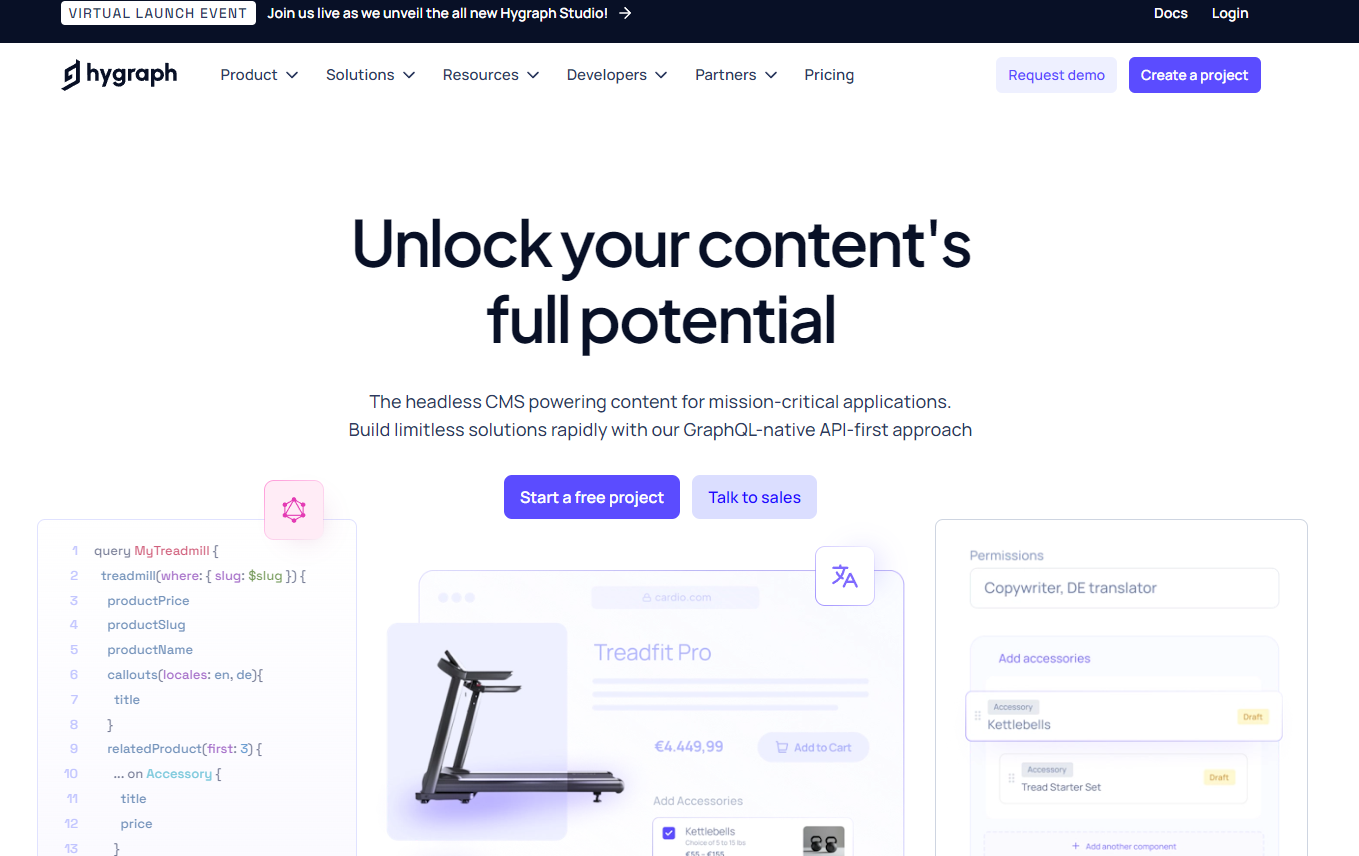July 1, 2024
Mastering Hygraph: Your Step-by-Step E-commerce Guide

Greg Kopyltsov
Founder
Hygraph


The world of e-commerce is evolving rapidly, and businesses are constantly looking for innovative ways to build and enhance their online presence. One of the key challenges in e-commerce development is finding a reliable and efficient content management system (CMS) that can handle the complex requirements of an e-commerce platform. This is where Hygraph comes into the picture.
Hygraph is a headless CMS that provides developers with a powerful and flexible solution for building e-commerce applications. Unlike traditional CMSs, which tightly couple the front-end and back-end aspects of a website, Hygraph decouples them, allowing developers to create the front-end using any technology or framework they prefer. This freedom enables developers to build highly customizable and scalable e-commerce apps.
Before diving into the details of building an e-commerce app with Hygraph, let's understand what a headless CMS is and why it is gaining popularity in the development community.
A headless CMS is a back-end-only content management system that separates the content repository from the front-end presentation layer. This decoupling allows developers to build the front-end using any technology they choose, while the CMS handles the content management and delivery via an API.
Hygraph is a native headless CMS that embraces the principles of GraphQL. It provides a content platform that delivers content as data via APIs, making it highly adaptable and suitable for a wide range of applications, including e-commerce.
To understand the benefits of using Hygraph for your e-commerce platform, it's essential to grasp the basics of a headless CMS.
Traditional CMS platforms, like WordPress or Drupal, handle both the front-end and back-end aspects of a website. They provide pre-built templates and themes, making it easier for non-technical users to create and manage content. However, these platforms often lack flexibility and can be limiting for developers who want more control over the front-end design and functionality.
Headless CMS, on the other hand, separates the content management system from the presentation layer. This decoupling allows developers to build the front-end using any technology they choose, while the CMS focuses solely on content management and delivery through APIs.
These APIs, known as content APIs, provide developers with the flexibility to fetch and display content from the CMS on various platforms, including websites, mobile apps, and other digital channels. This approach empowers developers to create highly customized and interactive user experiences.
When it comes to building an e-commerce platform, there are several CMS options available in the market. However, Hygraph stands out as a preferred choice for developers due to its unique features and benefits.
First and foremost, Hygraph is a GraphQL native headless CMS. GraphQL is a query language for APIs that allows developers to request specific data from the server, reducing the amount of data transfer and improving performance. With Hygraph's GraphQL capabilities, developers can efficiently retrieve and manipulate content, making it an ideal choice for e-commerce platforms with complex data requirements.
Secondly, Hygraph provides a powerful and user-friendly content platform. It offers a seamless and intuitive UI for content creation and management, making it easy for non-technical users to update and maintain the content of the e-commerce app.
Lastly, Hygraph's content platform enables developers to create rich and interactive user experiences. Its APIs offer precise content selection, filtering, ordering, pagination, and mutation capabilities, allowing developers to customize the app's functionality and deliver a personalized shopping experience to users.
Before diving into the technical aspects of building an e-commerce app with Hygraph, it's crucial to plan and define your business objectives and target audience. This pre-development phase plays a significant role in the success of your e-commerce venture.
To start, clearly define your business objectives. Are you looking to increase sales, expand your customer base, or enhance brand visibility? Understanding your goals will help you make informed decisions throughout the development process.
Next, identify your target audience. Who are your ideal customers? What are their preferences, needs, and pain points? This information will shape the design, functionality, and content strategy of your e-commerce app.
Additionally, consider whether you want to develop a mobile app alongside your website. With the increasing usage of smartphones for online shopping, having a mobile app can provide a seamless and user-friendly experience for your customers.
When defining your business objectives for your e-commerce app, it's important to align them with your overall e-commerce strategy. Here are a few key considerations:
Keep these objectives in mind as you plan and develop your e-commerce app with Hygraph. Your content strategy should align with your business objectives, ensuring that your content resonates with your target audience and drives them to take action.
Identifying your target audience is a critical step in developing an e-commerce app that meets their needs and preferences. Here's how you can define your target audience:
By identifying and understanding your target audience, you can develop a web app with Hygraph that caters to their specific needs, leading to increased engagement, conversions, and customer satisfaction.
Designing the architecture of your e-commerce app is a crucial step in ensuring its scalability, performance, and ease of maintenance. Here are the key aspects to consider:
By carefully designing the architecture of your e-commerce app, you can ensure a smooth development process and deliver an app that meets the needs of both your business and your customers.
Schemas play a crucial role in defining the structure and relationships between different types of content in Hygraph. Here's an overview of Hygraph schemas and their importance in content management:
By leveraging Hygraph schemas, you can create a well-structured and organized content management system for your e-commerce app, making it easier to manage and deliver content to your users.
Setting up product catalogs and categories is a fundamental step in building an e-commerce app. Here's how you can organize your product catalog and categories in Hygraph:
By organizing your product catalog and categories in Hygraph, you can create a streamlined and user-friendly shopping experience for your customers.
User authentication and authorization are vital aspects of building a secure and personalized e-commerce app. Here's how you can integrate these features with Hygraph:
By integrating user authentication and authorization with Hygraph, you can ensure a secure and personalized experience for your app users, fostering trust and loyalty.
Once you have planned and designed the architecture of your e-commerce app, it's time to start the development process. Here's an overview of the key steps involved in developing the app with Hygraph:
By following these steps, you can develop a robust and scalable e-commerce app with Hygraph, leveraging its powerful backend capabilities and flexible frontend integration.
Configuring the backend of your e-commerce app with Hygraph involves setting up a project and configuring the necessary components. Here's an overview of the key steps:
By configuring the backend with Hygraph, you can create a robust and scalable foundation for your e-commerce app, ensuring seamless content management and delivery.
Building a frontend that connects with Hygraph involves integrating the CMS with your chosen frontend technology or framework. Here's an overview of the key steps:
By building a frontend that connects with Hygraph, you can create a seamless and engaging user interface for your e-commerce app, leveraging the power and flexibility of a headless CMS.
Implementing shopping cart and checkout processes is a crucial aspect of any e-commerce app. Here's how you can achieve this with Hygraph:
By implementing shopping cart and checkout processes with Hygraph, you can create a seamless and user-friendly shopping experience for your customers, leading to increased conversions and customer satisfaction.
Before launching your e-commerce app, it's crucial to thoroughly test and ensure its quality. Here are the key steps involved in testing and launching your app:
By following a comprehensive testing process and using a pre-launch checklist, you can launch a high-quality and reliable e-commerce app to the market.
Quality assurance (QA) is a critical aspect of building an e-commerce app that meets the highest standards of quality and reliability. Here are some key strategies and best practices for QA and testing:
By following these QA and testing strategies, you can identify and fix any issues in your e-commerce app before it is launched, ensuring a seamless and reliable user experience.
Before launching your e-commerce app, it's important to go through a pre-launch checklist to ensure that all necessary components and features are in place. Here's a comprehensive pre-launch checklist for your reference:
Once your e-commerce app is launched, it's important to focus on marketing and scaling efforts to drive traffic and increase sales. Here are some key strategies to consider:
By focusing on marketing and scaling your e-commerce app, you can increase its reach and drive sustained growth for your business.
Search engine optimization (SEO) is crucial for improving the visibility and organic traffic of your e-commerce app. Here are some key SEO best practices for e-commerce:
By following these SEO best practices, you can increase the visibility and organic traffic of your e-commerce app, leading to higher conversions and sales.
Social media and email marketing are powerful tools for promoting your e-commerce app and engaging with your target audience. Here's how you can leverage these channels effectively:
By leveraging social media and email marketing, you can expand your app's reach, drive traffic, and cultivate a loyal customer base.
KeywordSearch has an AI Audience builder that helps you create the best ad audiences for YouTube & Google ads in seconds. In a just a few clicks, our AI algorithm analyzes your business, audience data, uncovers hidden patterns, and identifies the most relevant and high-performing audiences for your Google & YouTube Ad campaigns.
You can also use KeywordSearch to Discover the Best Keywords to rank your YouTube Videos, Websites with SEO & Even Discover Keywords for Google & YouTube Ads.
If you’re looking to SuperCharge Your Ad Audiences with AI - Sign up for KeywordSearch.com for a 5 Day Free Trial Today!
Building an e-commerce app with Hygraph can revolutionize your online business. By understanding the power of headless CMS and the flexibility it offers, you can create a seamless and dynamic user experience. Planning, designing, developing, testing, and marketing your app are crucial steps in ensuring its success. With a focus on quality and optimization, your e-commerce platform can attract, convert, and retain customers effectively. Embrace the potential of Hygraph to enhance your online presence and drive your e-commerce business towards growth and success.
The time required to build an e-commerce app with Hygraph depends on various factors, including the complexity of your app, the scope of features, and the team's expertise. On average, building and launching an e-commerce app can take anywhere from a few weeks to a few months.
Yes, it is possible to migrate your existing e-commerce site to Hygraph. However, the migration process will depend on the complexity of your existing site and the data migration requirements. It is recommended to consult with a Hygraph expert or development team to plan and execute a smooth migration.
The costs associated with using Hygraph for your e-commerce app will depend on various factors, such as the size and complexity of your app, the number of users, and your hosting and infrastructure requirements. It is best to consult with the Hygraph team or a development agency to get an accurate cost estimate based on your specific requirements